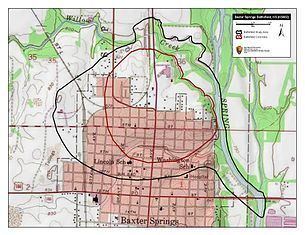Date 6 October 1863 | ||
 | ||
400 mounted guerrillas 96 infantry200 cavalry1 mountain howitzer Combatants Confederate States of America, Union Similar American Civil War, Battle of Dry Wood Creek, First Battle of Memphis, Manassas Campaign, Battle of Baton Rouge | ||
Battle of baxter springs
The Battle of Baxter Springs, more commonly known as the Baxter Springs Massacre, was a minor battle of the American Civil War, fought on October 6, 1863, near the present-day town of Baxter Springs, Kansas.
Contents
- Battle of baxter springs
- Fight at the fort
- Massacre of Blunts column
- Quantrills demand
- Aftermath
- References
In late 1863, Quantrill's Raiders, a large Confederate guerrilla band, was traveling south through Kansas along the Texas Road to winter in Texas. Numbering about 400, this group captured and killed two Union teamsters who had come from a small Federal Army post called Fort Blair (frequently referred to as Fort Baxter).
Fight at the fort
Quantrill decided to attack Fort Baxter and divided his force into two columns, one under him and the other commanded by a subordinate, David Poole. Poole and his men proceeded down the Texas Road, where they encountered Union soldiers, most of whom were African Americans. They chased and attacked the Union troops, killing some before the soldiers reached the earth and log Fort Blair. The garrison there consisted of about 25 cavalry and 65-70 infantry men of the United States Colored Troops.
Poole's column attacked the fort, but the garrison fought them off. 1st Lt. James Burton Pond received the Medal of Honor for leading the defense of the fort. The citation for his Medal of Honor reads:
For extraordinary heroism on 6 October 1863, while serving with Company C, 3d Wisconsin Cavalry, in action at Baxter Springs, Kansas. While in command of two companies of Cavalry, First Lieutenant Pond was surprised and attacked by several times his own number of guerrillas, but gallantly rallied his men, and after a severe struggle drove the enemy outside the fortifications. First Lieutenant Pond then went outside the works and, alone and unaided, fired a howitzer three times, throwing the enemy into confusion and causing him to retire.The American flag would remain standing over the fort thanks to the bravery of the 2nd Kansas Colored Infantry who helped rally the white federal soldiers.
Massacre of Blunt's column
Moving out on to the prairie, Quantrill's column happened to encounter a Union detachment escorting Maj. Gen. James G. Blunt, who was moving his command headquarters south from Fort Scott, Kansas to Fort Smith, Arkansas. They greatly outnumbered the Union forces.
Wearing Federal uniforms and thereby taking the Federals by surprise, Quantrill's column killed most of the detachment including many who attempted to surrender. Among the dead was a military band, Maj. Henry Z. Curtis (son of Maj. Gen. Samuel R. Curtis), and Johnny Fry (first official westbound rider of the Pony Express), a total of 103 men. Also killed was James R. O'Neill, an artist-correspondent for Leslie's Weekly. When a few men escaped to Fort Baxter, soldiers went out to find Blunt and survivors; there were few.
Quantrill's demand
After the massacre of Blunt's troops Quantrill sent a demand ordering Pond to surrender the Fort. Pond refused the surrender. Bloody Bill wanted to attack the fort again, but Quantrill refused and the guerrillas left for Texas.
Aftermath
Blunt was removed from command for failing to protect his column, but he was soon restored.
Union supporters called the killings a massacre; the conflict at Baxter Springs was characteristic of the vicious Kansas-Missouri border warfare. Fort Baxter was temporarily reinforced but by the end of 1863, the Union Army pulled its troops back to Fort Scott, which was better fortified. Before abandoning the fort, US forces demolished it and took away everything usable, to avoid its being used by the enemy. Quantrill and Anderson would continue to disagree on how to conduct warfare in the Kansas-Missouri border. In 1864 the two split off going their separate ways limiting the Bushwhackers use to fighting in Missouri only.
Baxter Springs later developed as the first "cow town" in Kansas, a way station for cattle drives to markets and railroads further north. By 1875 it had a population estimated at 5,000.
